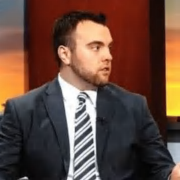Revealing the 50 Most Influential Teams in NFL History: Nos. 40–31

Here at Sports Illustrated, we embarked on a journey with the hope of finding the 50 most impactful teams in NFL history. Our process was simple.
Watch the NFL with Fubo. Start your free trial today.
During the offseason we brought together a 31-person blue-ribbon panel consisting of media members, analysts, former front office personnel and more, having each vote on more than 100 candidates. Each panelist voted for 50 teams, with their top team earning 50 points and their 50th team garnering a single point.
- Follow along with each reveal here: Counting Down the 50 Most Influential
From those tallies, we detailed why each team deserves to be on the list, including quotes from panelists for every squad. Most importantly, SI reached out to a star player or head coach for every team from the Super Bowl era (1966 to present), gaining valuable insight into what made those teams so unique.
Below are the panelists and their titles, followed by our list. Up next: numbers 40 to 31.
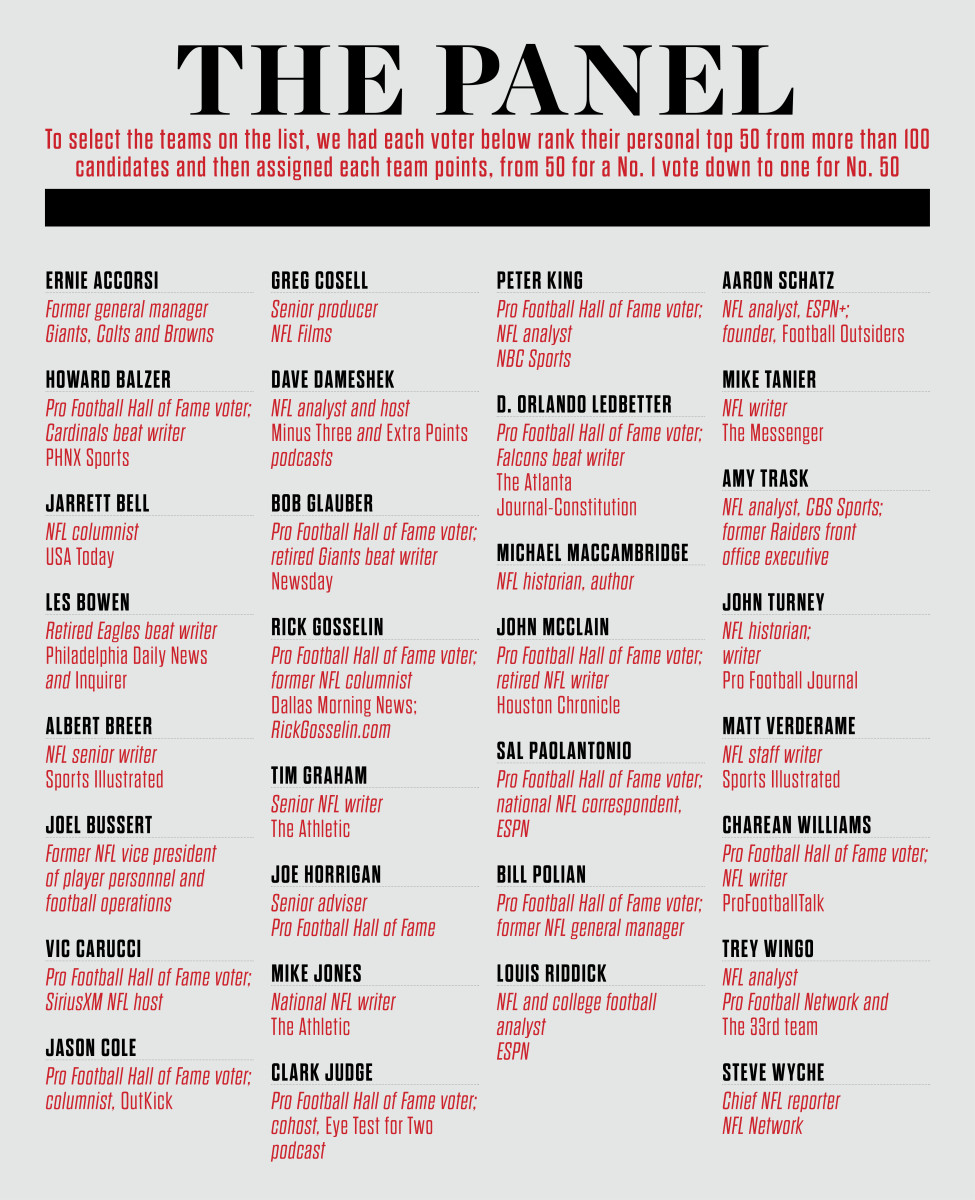
40. 1989 Los Angeles Raiders
Record: 8–8, missed playoffs
Coach: Art Shell
Hall of Famers: Art Shell (HC), Tim Brown (WR), Howie Long (DT), Mike Haynes (CB), Marcus Allen (RB)
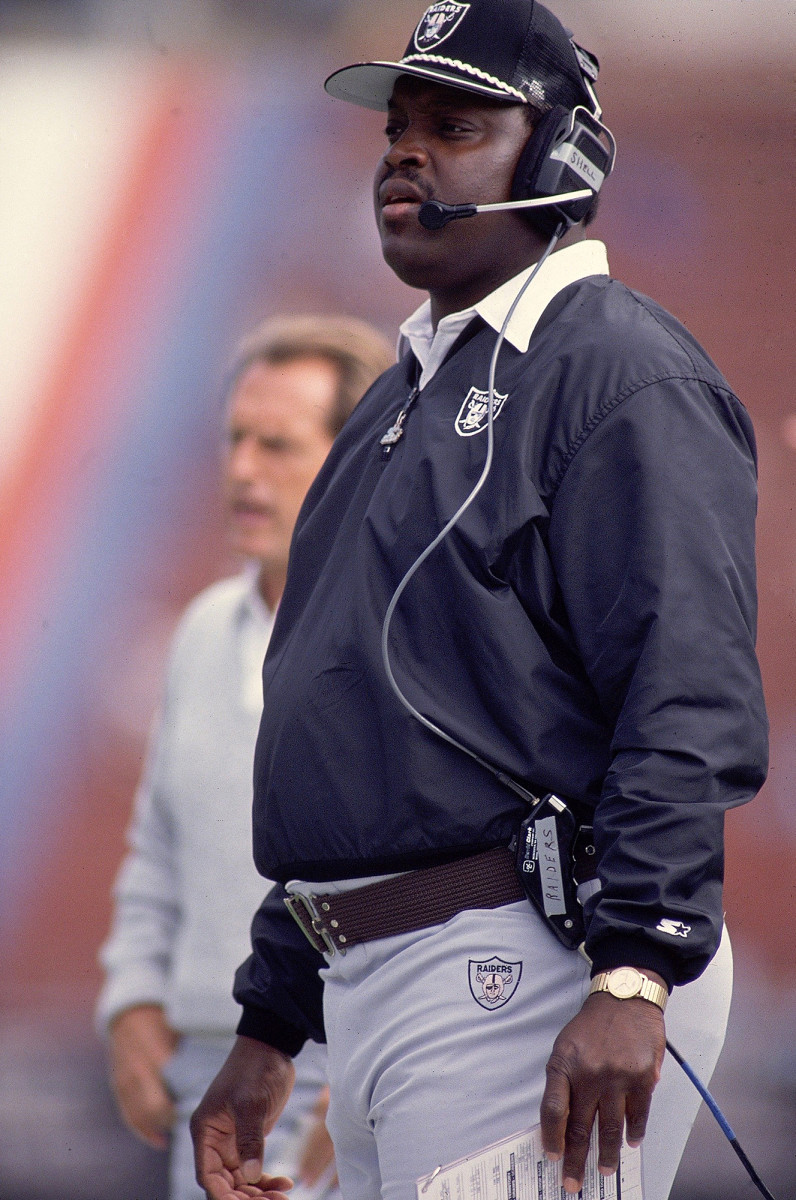
Why they mattered:
Only two years after Doug Williams broke down barriers for Black quarterbacks, Art Shell did the same for coaching.
Shell enjoyed an illustrious career with the Raiders from 1968 to ’82, winning two Super Bowls as a member of the 1970s All-Decade Team. The left tackle was eventually enshrined in Canton, but his greatest impact was donning a headset for Los Angeles.
In 1989, Raiders owner Al Davis hired Shell to become his coach after firing Mike Shanahan four games into the season. The decision made Shell the first Black man to become a head coach since Fritz Pollard did so with the Hammond Pros in ’25. Shell enjoyed success with Los Angeles, guiding the franchise to four winning seasons and three playoff berths, including a trip to the AFC championship game in his second year.
While Shell never reached the Super Bowl as a coach, he was a pioneer, helping others get an opportunity. In the years since, two Black men (Tony Dungy, Mike Tomlin) have coached their teams to titles. Super Bowl XLI also saw a milestone when both coaches were Black—Dungy and the Bears’ Lovie Smith.
Panel quote:
“Al Davis again demonstrated that he was a maverick and that he was decades ahead of his time when he named Art Shell as head coach in 1989, continuing his practice of hiring without regard to race, gender, ethnicity and other individualities which have no bearing on whether one can do a job. He had previously named Tom Flores head coach in the late ’70s, and he hired me in the mid ’80s.” —Amy Trask, CBS Sports NFL analyst; former Raiders front office exec
Team quote:
“I’m proud to say that I was given an opportunity to do something that me as well as Blacks in this country. You can’t get around that. It was huge. But I didn’t look at it that way. I played for the Raiders and I understood the history of the Raiders, and Al Davis, and what it took to win, and what was necessary in order for the coach to win. … [The players] understood the magnitude of it, too. Being the second Black in the history of the National Football League to become a head coach, that was special. It was inspiring for them, and still with others around this nation, that they, too, given the opportunity, could have some success.” —Art Shell, Raiders coach, 1989–94 and 2006
39. 1980 Oakland Raiders
Record: 11–5, Super Bowl XV champions
Coach: Tom Flores
Hall of Famers: Tom Flores (HC), Ted Hendricks (LB), Gene Upshaw (G), Art Shell (OT), Cliff Branch (WR), Dave Casper (TE), Ray Guy (P)
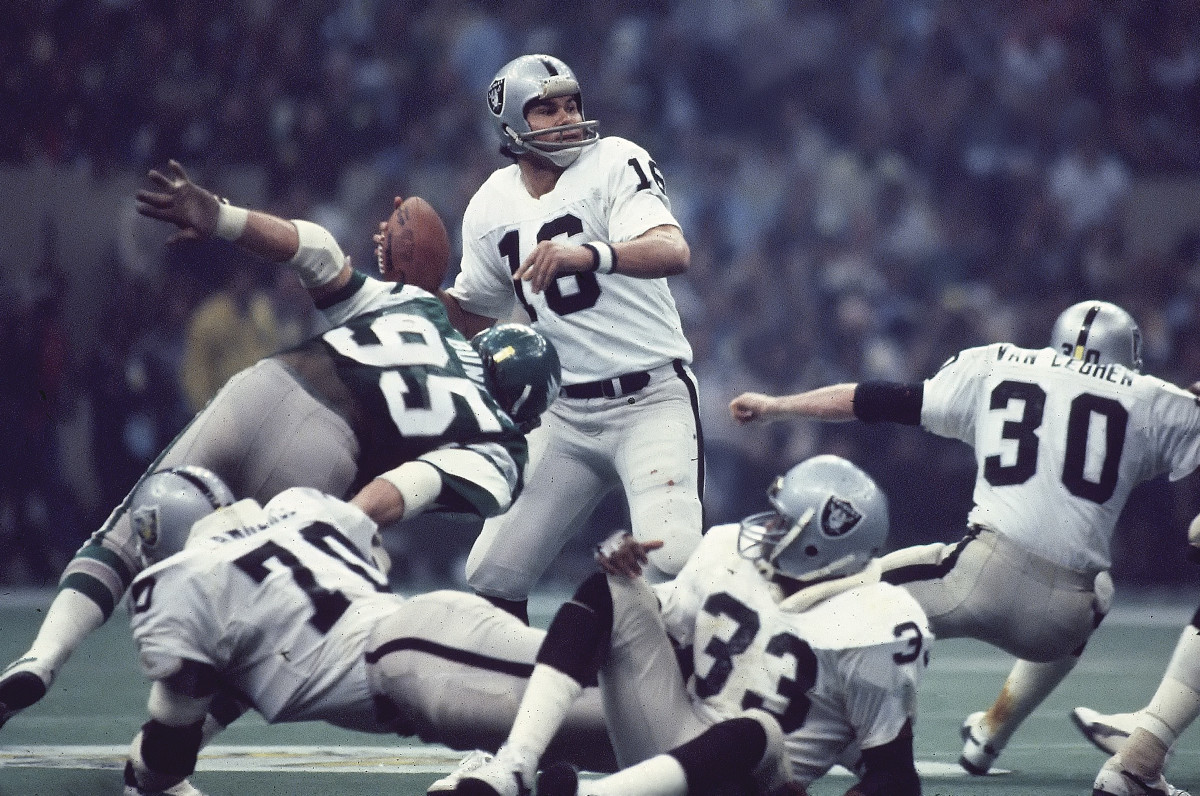
Why they mattered:
The 1980 Raiders might be one of the most unlikely Super Bowl champions in NFL history.
They won without a Hall of Fame quarterback, Jim Plunkett, who was a castoff and backup to begin the year. Yet, the defense was the team’s backbone, totaling 54 unofficial sacks (sacks didn’t become official until 1982), while corner Lester Hayes had 13 interceptions, the second-highest single-season mark in league history.
But the 1980 Raiders were the first wild-card team to win the Super Bowl in the post-merger era. While the ’69 Chiefs also were a champion born from a wild-card berth, they needed to survive only three games for a title. The Raiders, under a new postseason format introduced in ’78, had to win four.
Oakland was able to do exactly that, a feat that wouldn’t be duplicated in a nonstrike season until the ’97 Broncos did so en route to winning quarterback John Elway’s first title.
For the Raiders, it was their second Super Bowl victory of three within a span of eight seasons. For the NFL, it was proof that wild-card teams in the 10-team format (which ran from 1978 to ’89 before expanding once more) weren’t wasting everyone’s time.
Panel quote:
“In Tom Flores’s second season as head coach following the retirement of John Madden after the 1978 season, the Raiders became the first wild-card team to advance to the Super Bowl, which they won. They were 9–7 in ’79 and acquired quarterback Dan Pastorini from the Oilers for Ken Stabler prior to the ’80 season. With a record of 2–3, Pastorini was injured and replaced by Jim Plunkett, who spurred the team to a 9–2 finish, including six straight wins to end the regular season. Although Plunkett’s heroics have always been the headline, the defense recorded 52 takeaways and 35 interceptions, including 13 by league-leader cornerback Lester Hayes. They added 16 takeaways [with another five picks by Hayes] in four playoff wins over the Oilers, Browns, Chargers and Eagles.” —Howard Balzer, Pro Football Hall of Fame voter
Team quote:
“Different players stepped up each and every game. It wasn’t the same guy making the big play, or stopping the run, or stopping the pass. Everybody played their part, especially on that [1980] team. I think that’s what got us over the hump. If we needed a big play throwing the football, we came up with it. If we needed an interception right before they were going to score, we got it. … I couldn’t be more proud of a team coming from a wild card and accomplishing what we accomplished.” —Jim Plunkett, Raiders quarterback 1980–86
38. 1970 Cincinnati Bengals
Record: 8–6, lost in AFC divisional round
Coach: Paul Brown
Hall of Famers: Paul Brown (HC), Ken Riley (CB)
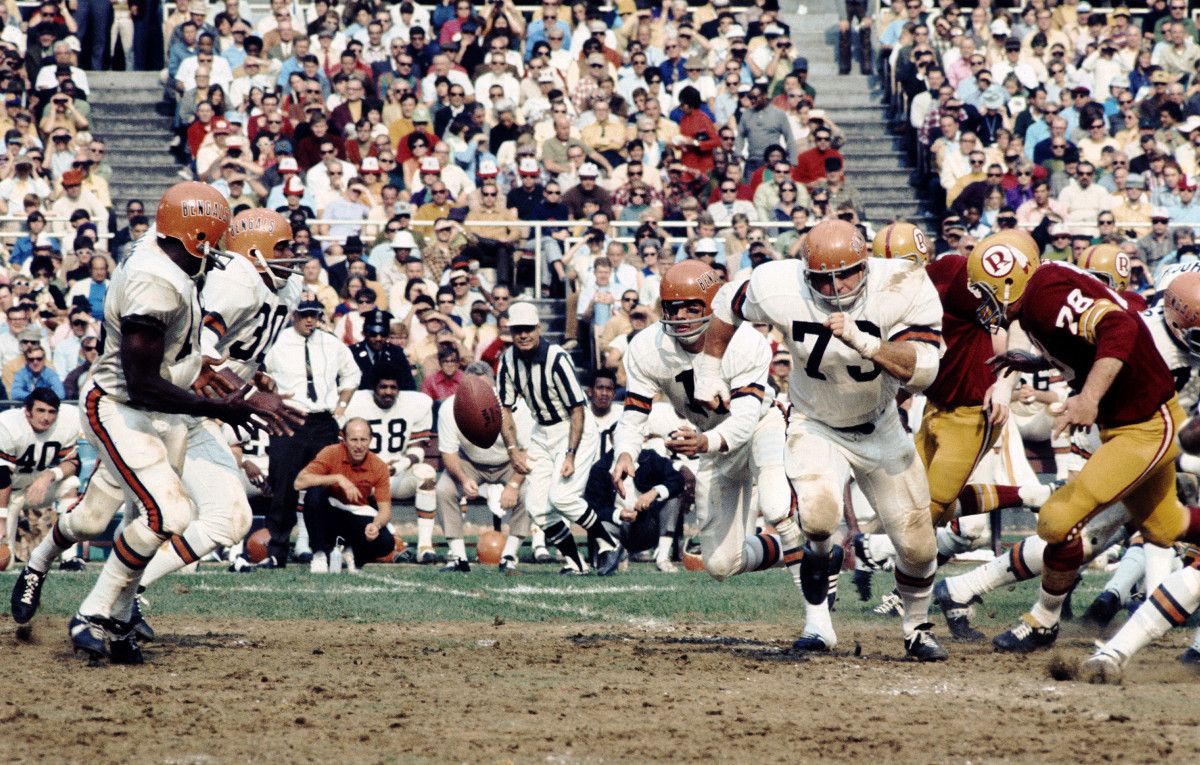
Why they mattered:
The West Coast offense didn’t start in San Francisco. Rather, it began taking shape in Cincinnati.
In 1970, the Bengals were in their third year of existence. Their star second-year quarterback, Greg Cook, was out for the season recovering from a rotator cuff injury sustained the prior year. Cincinnati’s offensive coordinator, Bill Walsh, had to figure out how the Bengals could move the ball with backup signal-caller Virgil Carter playing behind a substandard line.
The result was Walsh devising a scheme where Carter would throw short, quick passes to the flats and underneath, allowing for Cincinnati’s backs and receivers to gain most of their yards after the catch. That season, the Bengals had seven players catch at least 15 passes, with three of them being backs.
Cincinnati’s offense ultimately ranked seventh in points for and helped the team go from 1–6 to AFC Central champions with a seven-game winning streak to close out the season. While Walsh never ascended over Brown to become the team’s coach, he eventually got his chance with the 49ers in 1979.
Walsh went on to revolutionize the pro game with his offensive innovations, winning three Super Bowls between 1981 and ’88. Today, every NFL team has a litany of concepts stolen from Walsh in their playbooks.
Panel quote:
“Walsh had to figure out a way to move the ball and sustain offense without really being able to be explosive. He created an offense in which the run game and pass game almost had similar concepts. The run game is the run game, obviously, but the pass game would be quicker, shorter throws which would sustain offense because they couldn’t really create explosive plays that were en vogue at the time.” —Greg Cosell, senior producer, NFL Films
Team quote:
“I questioned Walsh several times after he retired and I’d go out and visit him in San Francisco, and say how did you come up with [the West Coast offense]? What was the first thing? He said we threw the ball away too much. … We were never going to throw the ball away and just heave it someplace. We’re going to throw it to somebody. Make the defense make the play, every play. That’s what Walsh told me and that was the science for the West Coast offense. We are not going to give in to the defense on any play.” —Bob Trumpy, Bengals tight end, 1968–77
37. 1925 Red Grange Barnstormers
Record: 13-5-1
Coach: George Halas
Hall of Famers: George Halas (HC), Red Grange (RB), Ed Healey (OT), George Trafton (C), Link Lyman (LT)
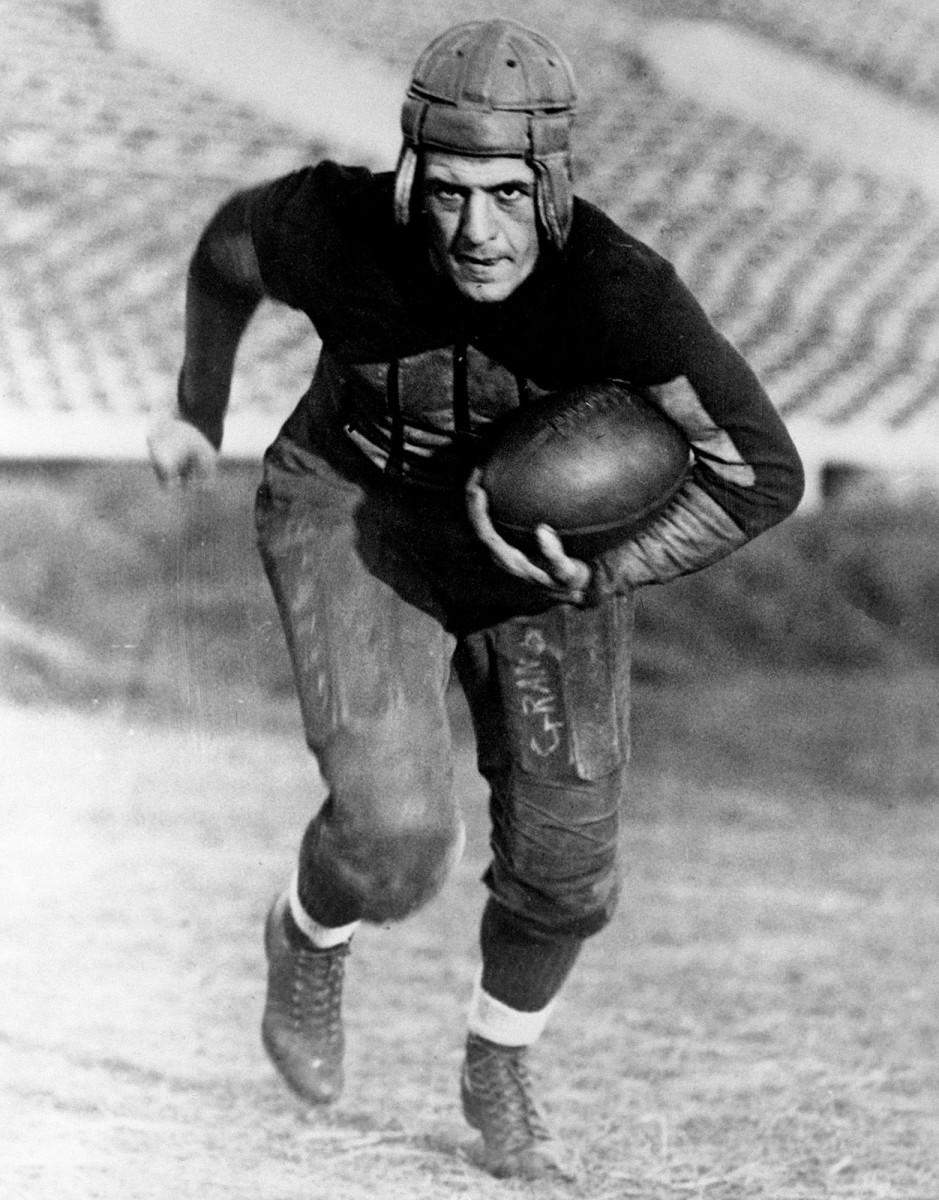
Why they mattered:
No team was more instrumental to the survival of the NFL than the 1925 Bears. Yet many forget about the ensuing Red Grange Barnstorming Tour (a 19-game schedule consisting of NFL and nonleague games), something unique to the annals of pro football history.
By signing Grange through negotiations with agent C.C. Pyle—a revolutionary idea at the time—the Bears immediately became one of the biggest stories in the U.S. Unlike today, there was no draft, which meant Grange was free to sign once his season with the University of Illinois ended. He did so in mid-November and played his first game for Chicago on Thanksgiving in an intercity battle against the Cardinals.
While the game ended 0–0, the important note was an attendance figure of 40,000.
Come December, the Bears played seven official games against league competition in 18 days. The most important was a 19–7 win over the Giants at the Polo Grounds, bringing 73,000 fans through the gate, relieving team owner Tim Mara of considerable debt.
All told, the barnstorming tour saw Grange’s group play against All-Star teams around the country, ranging from a game in Coral Gables, Fla., on Christmas, to contests in Portland and Seattle. Due to the demand of Grange around the nation, the Bears also played three All-Star games in the midst of their league slate, winning two of them. However, the brutal schedule took a toll, resulting in a slew of injuries and three consecutive league defeats.
“The 1925 Chicago Bears impacted pro football greatly. Their record was lackluster, but at the end of the season, they signed the most famous collegiate player in America, Red Grange. The ‘Galloping Ghost’ was known to fans everywhere by radio and movie newsreels. Bears coach George Halas put together a postseason tour, venturing coast to coast, playing 19 games in 67 days. Virtually every game was a sellout. NFL owners in other cities in which the tour played made a profit for the first time in their short history. And the U.S. was introduced to, and noticed, the NFL.” —Bill Polian, former NFL general manager, six-time Executive of the Year
36. 1977 Dallas Cowboys
Record: 12–2, Super Bowl XII champions
Coach: Tom Landry
Hall of Famers: Tom Landry (HC), Roger Staubach (QB), Cliff Harris (S), Mel Renfro (CB), Drew Pearson (WR), Rayfield Wright (OT), Randy White (DT), Tony Dorsett (RB)
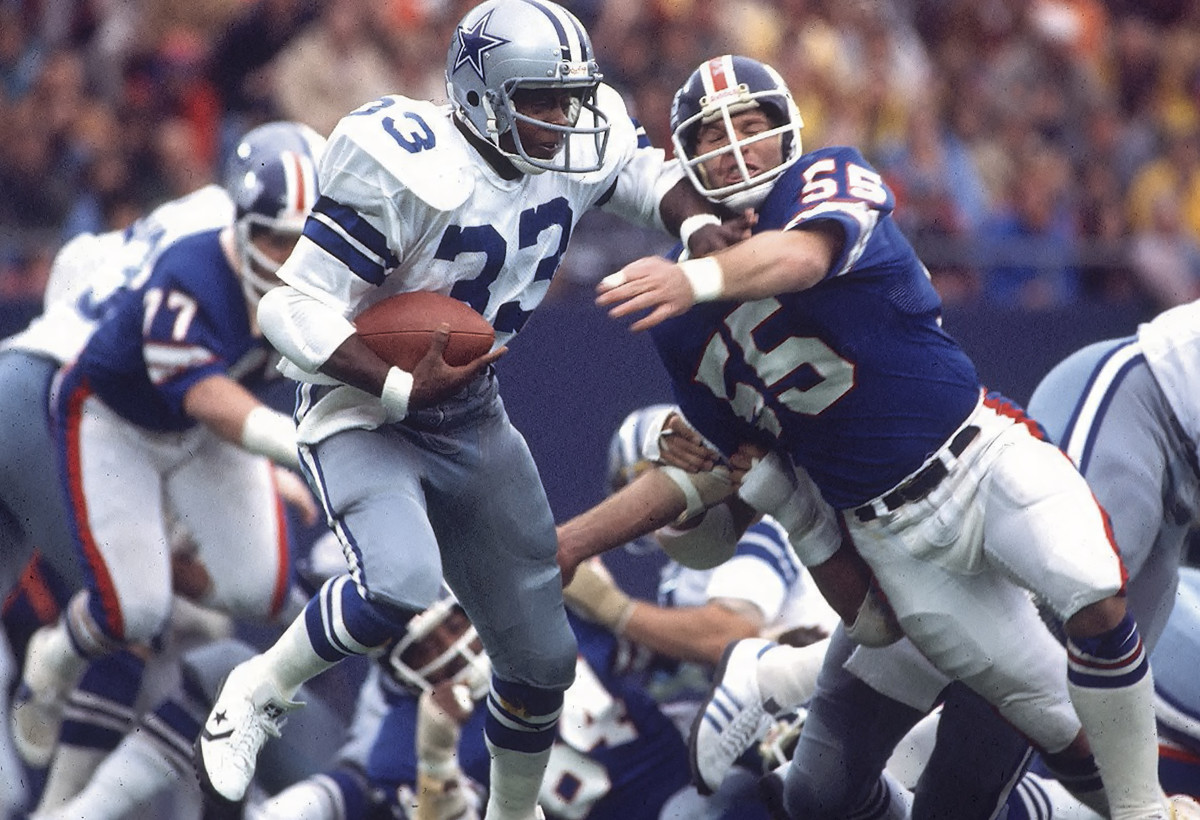
Why they mattered:
Few teams have been more nationally acclaimed than the 1977 Cowboys.
That year, Dallas rolled through the NFC playoffs, beating the Bears and Vikings by a combined score of 60–13 before destroying the Broncos and their “Orange Crush” defense in Super Bowl XII, 27–10.
Of everything, the Cowboys’ “flex” defense might be the biggest lasting impact. Coach Tom Landry was one of the game’s great innovators and utilized his scheme to perfection in 1977, solidifying the second generation of the “Doomsday Defense.” The basic premise was attacking gaps while asking players to occupy identified spaces, all while playing a 4–3 look. The result was an unofficial 53 sacks (sacks weren’t an official stat until ’82), with defensive end Harvey Martin leading the league with 20.
The Cowboys were powered by an all-time roster, including Roger Staubach in the shotgun and running back Tony Dorsett beside him, who in his rookie campaign racked up 1,007 rushing yards and 12 touchdowns. Receiver Drew Pearson also led the NFL with 870 receiving yards, the last time a nonstrike year was paced by fewer than 1,000 yards.
Panel quote:
“The 1977 Cowboys are significant for so many reasons. The win in Super Bowl XII over the Broncos put an exclamation point on the Tom Landry era. It was his second Super Bowl win, validating his stature as a Hall of Fame coach. But the ’77 Cowboys also validated so many of the Landry innovations to the game. It was Landry’s Cowboys who brought back the shotgun snap in 1975—and also created the shovel pass, or the Utah pass as they called it—and made it relevant again. Both of those things are still such a big part of today’s game. The Super Bowl XII win also sealed Roger Staubach’s Hall of Fame credentials. The game itself also served as a fitting symbol for all of the things Landry preached. It’s still the only Super Bowl to have co-MVPs in Randy White and Harvey Martin, and the game showed off Landry’s aggressive play-calling with a touchdown pass thrown by fullback Robert Newhouse. What began in ’60 as a winless season culminated at the Superdome 18 years later. The Dallas dynasty and the nickname of “America’s Team” were forged in that 27–10 win over Denver.” —Trey Wingo, NFL analyst, Pro Football Network
Team quote:
“We had it all. What helped us is coach Landry’s innovative ways. We didn’t just play vanilla against teams. We made them think and react to what we’re doing. Our motion, our linemen coming out of the huddle, the shifting in the backfield. All of that stuff was calculated. When we do stuff like that, it creates a little indecision in the defense. We felt like every snap, we had an advantage. If we executed the plays that were called, we were going to have success with them.” —Drew Pearson, Cowboys receiver, 1973–83
35. 1984 Miami Dolphins
Record: 14–2, AFC champion
Coach: Don Shula
Hall of Famers: Don Shula (HC), Dan Marino (QB), Dwight Stephenson (C)
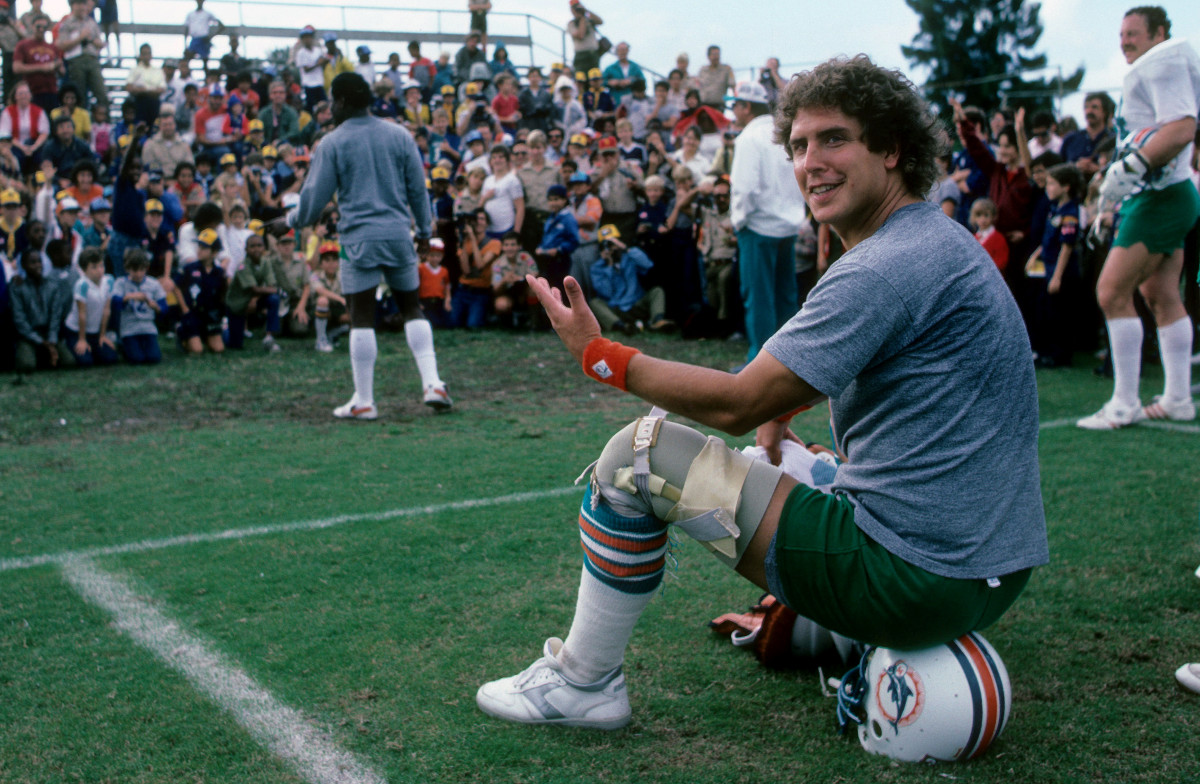
Why they mattered:
The aerial game was beginning to take off in the late 1970s and early ’80s with Air Coryell in San Diego and the liberalizing of downfield rules.
However, nobody threw the ball before 1984 like Dan Marino. In the 73 seasons preceding that season, nobody had thrown for more than 4,802 yards or 36 touchdowns. Playing with Mark Clayton and Mark Duper on the outside, Marino rewrote the record books, amassing 5,084 passing yards and 48 touchdowns in his first full year as a starter.
Marino’s 1984 season also dwarfed Dan Fouts’s 4,802-yard effort in ’81 based on efficiency. Fouts completed 59.1% of his attempts, averaging 7.9 yards. Marino came in at 64.2% and 9.0 yards per attempt, leading the league.
Marino also led a winner. Previous high-octane passing teams didn’t succeed, but Marino’s attack propelled Miami to the AFC’s top seed and a berth in Super Bowl XIX, where it lost to the 49ers.
Marino, a member of the famed 1983 draft class, had a leading role in the NFL becoming a passing league.
Panel quote:
“Dan Marino and Don Shula took what Joe Montana and Bill Walsh did to open up the passing game and put it on steroids. Marino’s 48 touchdown passes on the season completely reset the notion of how offense could be played, obliterating the previous high of 36 set twice in the early 1960s. Marino became a Ruthian figure and dominant in the emerging world of fantasy football. The way the Dolphins played opened up other ideas for wide-open offense such as teams embracing the run-and-shoot scheme. Marino’s statistical prowess never equated to winning titles. This was the only season that he went to a Super Bowl, and the Dolphins were thumped by the 49ers.” —Jason Cole, Pro Football Hall of Fame voter
Team quote:
“Dan [Marino] was such a wizard at knowing who had the mismatch and then getting them the ball. [Mark] Clayton ended up with most of the touchdowns that year, but you had touchdowns galore going around. You had a guy like Tony Nathan coming out of the backfield, who also was a hell of a running back who averaged [4.7] yards every time he ran the ball, and was also a great receiver. … We had a wide-open offense similar to San Diego’s, but we had more guys who could put the ball in the end zone once they got one-on-one.” —Nat Moore, Dolphins receiver, 1974–86
34. 1931 Green Bay Packers
Record: 12–2, NFL champions
Coach: Curly Lambeau
Hall of Famers: Curly Lambeau (HC), Cal Hubbard (OL/DL), Johnny “Blood” McNally (RB), Arnie Herber (QB), Mike Michalske (G)
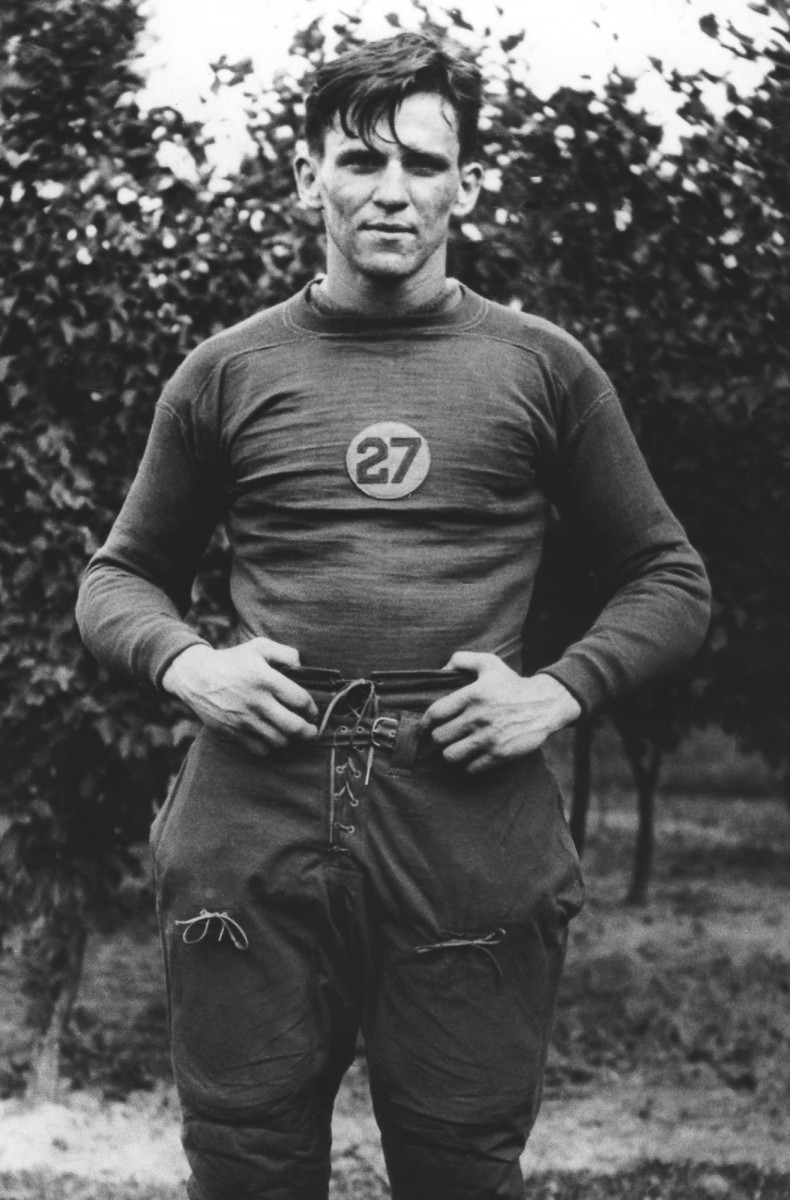
Why they mattered:
The 1929–31 Packers were the first franchise to win three consecutive NFL titles without relocation (see: the 1922–24 Bulldogs). Green Bay became a pro football dynasty under Curly Lambeau, with the league settling down from its days of teams entering and leaving on a weekly basis.
During their three-year reign, the Packers recorded a 34-5-2 mark. At the time, the best regular-season record won the league title, with the postseason not being introduced until 1932. Green Bay was loaded with five Hall of Famers in ’31, headlined by Herber, who played 16 seasons and was arguably the first impactful passer in NFL history. He led the league in touchdown passes and passing yardage three times, along with completion rate on two occasions.
Johnny McNally was also a star. While statistics from the time are sketchy, the Wisconsin native earned 1930s All-Decade Team honors from the Hall of Fame, helping him earn induction as a charter member in ’63.
Panel quote:
“The 291 points scored was more than 100 better than the second-place Portsmouth Spartans (175). They had a two-touchdown margin of victory per game. They also had great depth in the backfield. Green Bay had at least six runners carry the ball in each of its 14 games and had seven different backs pace the team in rushing for a particular game: Russ Saunders, Herdis McCrary, Bo Molenda, Wuert Engelmann, Mule Wilson, Hank Bruder and Verne Lewellen. They also had arguably the most exciting player in the league in Johnny Blood. Stats are sketchy in that era, but unofficially, based on Press-Gazette play-by-plays, Blood had 20 catches for 450 yards and 10 touchdowns.” —John Turney, NFL historian; writer, Pro Football Journal
33. 2006 Indianapolis Colts
Record: 12–4, Super Bowl XLI champions
Coach: Tony Dungy
Hall of Famers: Tony Dungy (HC), Peyton Manning (QB), Marvin Harrison (WR)
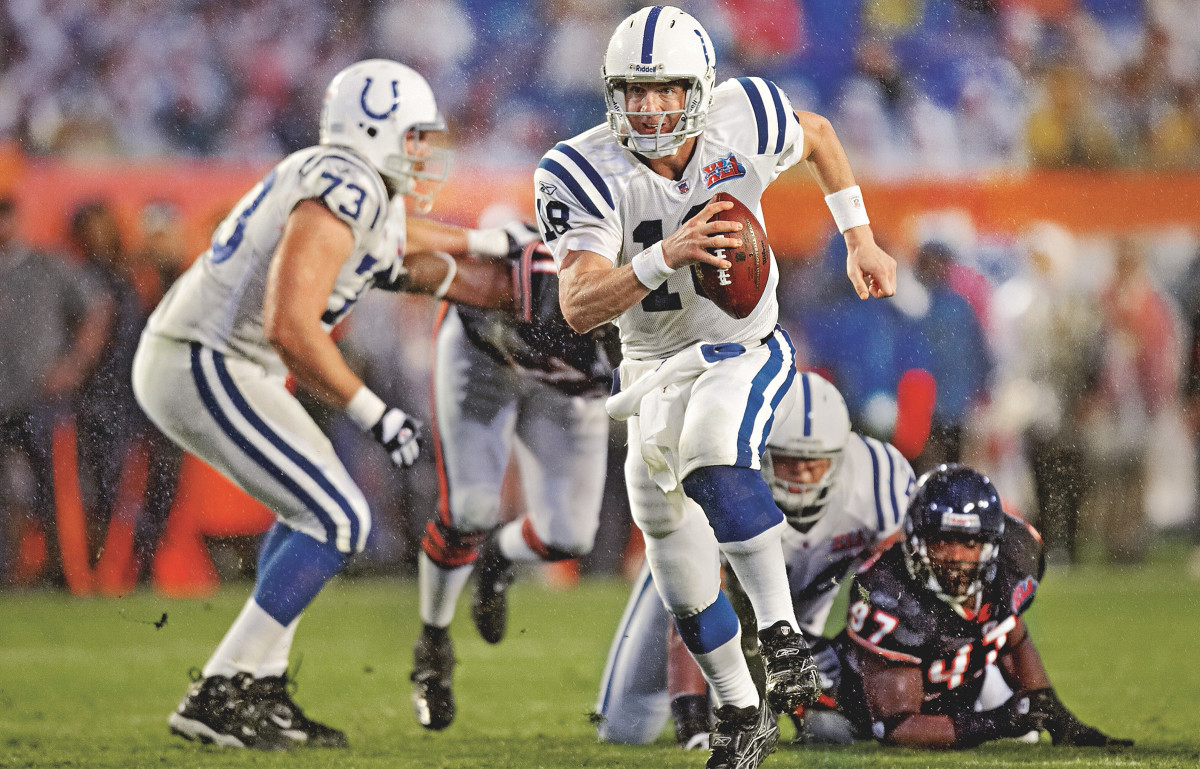
Why they mattered:
For years, the Colts and Patriots fought for AFC supremacy, and the Patriots usually won.
Not so in the 2006 season.
Indianapolis hosted the conference title game, fell behind 21–3 and then rallied to win. The victory sent Peyton Manning to the Super Bowl, and it set the stage for the first Super Bowl between two Black coaches, with the Colts’ Tony Dungy facing the Bears’ Lovie Smith.
Ultimately, it was Dungy who became the first Black coach to win an NFL title. The Steelers’ Mike Tomlin joined him two years later.
For Dungy, the road to Super Bowl glory was lined by having to overcome racism throughout his career. As a player with Pittsburgh, he was forced to change positions from quarterback to defensive back when no team would give him a chance under center. After retiring and becoming an assistant coach at multiple stops, Dungy was given the opportunity to run Tampa Bay in 1996, where he stayed for six seasons before taking over Indianapolis and winning it all.
Panel quote:
“Led by Peyton Manning and Tony Dungy, their high-flying, no-huddle offense, with Manning orchestrating their every move at the line of scrimmage prior to every snap, captured the imagination of the football world. The victory in Miami validated the no-huddle. The Colts’ win also reverberated outside the football community. Dungy earned his place in U.S. history by being the first Black coach in history to win the Super Bowl.” —Bill Polian, former NFL general manager, six-time Executive of the Year
Team quote:
“Obviously, it was a great win for the organization, the city and the state. That’s what we wanted to do. But it was gratifying going into it. The fact that not only were Lovie [Smith] and I were the first two African American coaches after 40 Super Bowls, but it made me think of coming into the league when there were only 10 assistant coaches in the whole league, no head coaches. Eighteen teams didn’t even have an African American coach on the staff. You think about how far we had come in our time. Then, leading up to the game, [Steelers owner] Dan Rooney hired Mike Tomlin. Now you think, boy, we are turning the corner.” —Tony Dungy, Colts coach, 2002–08
32. 2019 Kansas City Chiefs
Record: 12–4, Super Bowl LIV champions
Coach: Andy Reid
Likely Hall of Famers: Andy Reid (HC), Patrick Mahomes (QB), Travis Kelce (TE), Tyreek Hill (WR), Chris Jones (DT), Tyrann Mathieu (S)
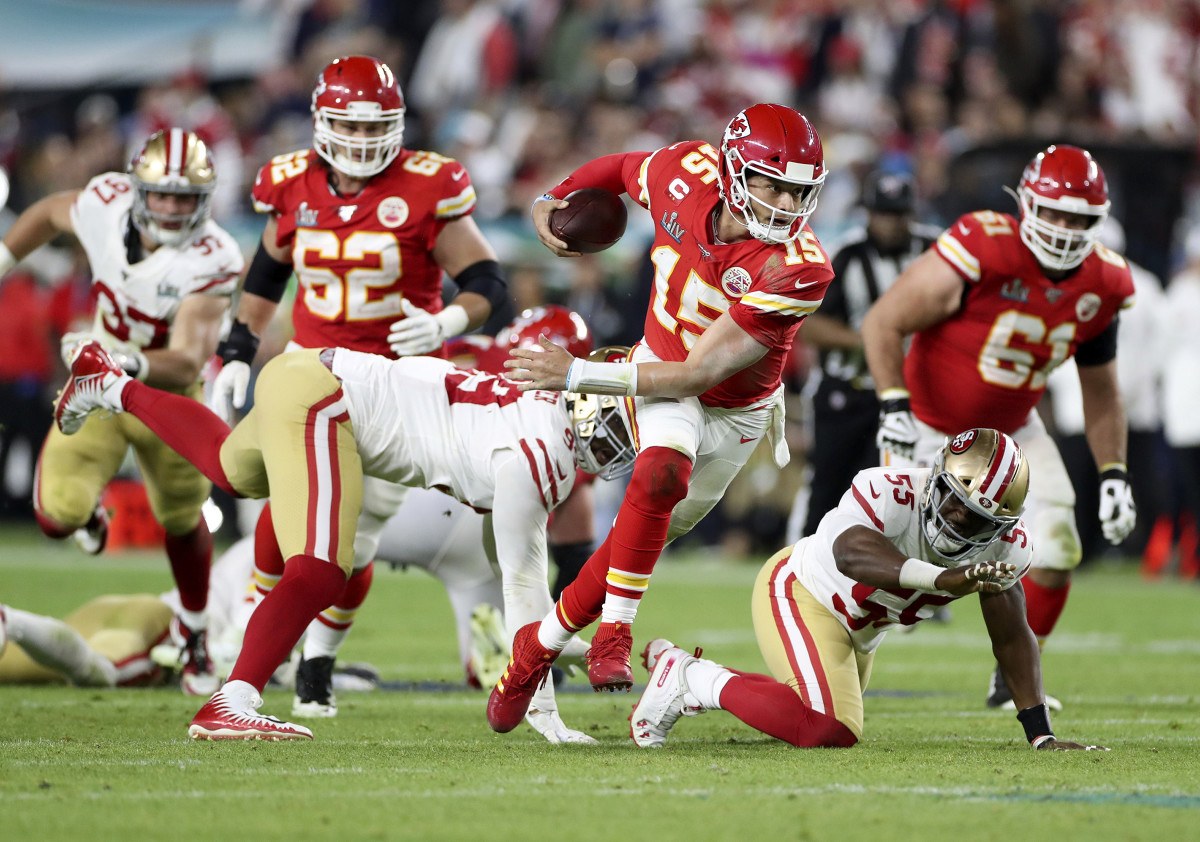
Why they mattered:
Few players in NFL history have had a bigger impact, both on the field and culturally, than Patrick Mahomes.
In 2018, Mahomes burst onto the scene as a first-year starter, winning MVP honors as only the second man in league history to throw for 5,000 yards and 50 touchdowns in the same season. But it was ’19 when Mahomes made his biggest splash. Despite trailing by double digits in each of Kansas City’s three playoff games, Mahomes and the Chiefs won the franchise’s first Super Bowl in 50 years.
By becoming a champion, both Mahomes and coach Andy Reid were validated, and so were their tactics.
For Mahomes, winning a ring ensured his unique brand of football wouldn’t be labeled as gimmicky, but instead be seen as an avenue to a championship. The result has been a mass influx of quarterbacks who play more on the move, off-platform and with a variety of arm angles throwing the ball.
As for Reid, the coach had long been seen as an offensive genius but perhaps incapable of winning a Super Bowl. After 20 seasons of often coming close but never winning it all, Reid found the right quarterback, and the pinnacle.
Panel quote:
“The 2019 Chiefs officially marked the passing of the torch in the NFL from Tom Brady and Bill Belichick’s Patriots being the team everyone had to beat, to Patrick Mahomes and Andy Reid’s Chiefs being the gold standard. Think about what’s happened since then. The Chiefs have played in two more Super Bowls and won one, and certainly look as if they have it in them again this season to get back to another. It also changed the narrative of elite quarterback play from Brady’s surgical pocket approach to the creative genius of Mahomes. That year also gave Reid the one thing that had been missing from his résumé … a ring. That Chiefs team also showed the value of speed everywhere with the likes of Mecole Hardman, Tyreek Hill and Sammy Watkins. Think the league didn’t notice? Look at the current Miami Dolphins.” —Trey Wingo, NFL analyst, Pro Football Network
Team quote:
“Our ability offensively to make a defense [prepare] going into any game, any week and play to play, for the versatility of being able to attack in any variety. Then you combine that with three Hall of Famers in Patrick [Mahomes], Travis [Kelce] and Tyreek [Hill]. Coach Reid is going to go down as one of the best coaches in history. It was a deadly combination of everything that was happening at once with an amazing coach and an amazing group of players.” —Mitchell Schwartz, Chiefs tackle, 2016–20
31. 2016 New England Patriots
Record: 14–2, Super Bowl LI champions
Coach: Bill Belichick
Likely Hall of Famers: Bill Belichick (HC), Tom Brady (QB), Rob Gronkowski (TE)
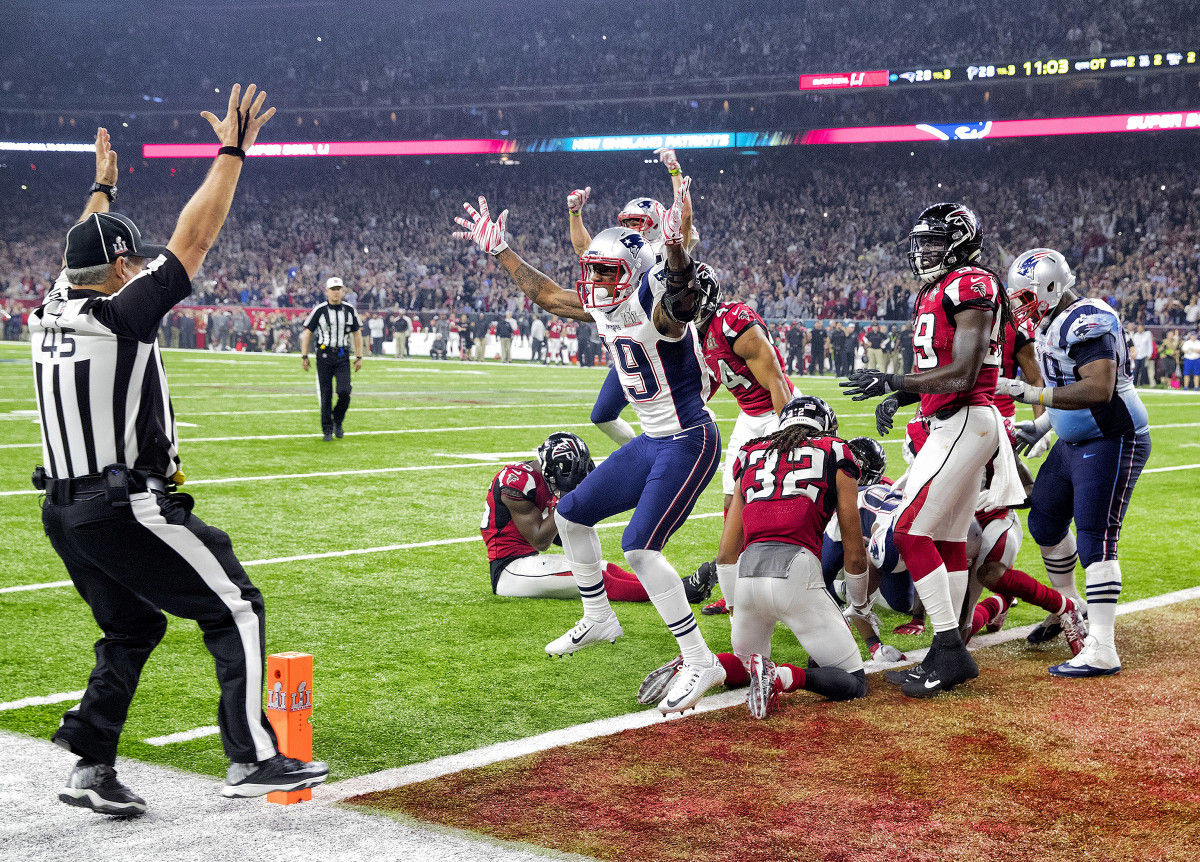
Why they mattered:
The Patriots were already one of the league’s great dynasties after winning three Super Bowls between the 2001 and ’04 seasons. However, New England then went 10 years before finally winning another title by beating the Seahawks in ’14.
Two years later, the Patriots solidified the second phase of their dynasty by staging the greatest comeback in Super Bowl history. After falling behind 28–3 against the Falcons, New England roared back and won the first overtime game played on Super Sunday, earning a 34–28 victory.
For quarterback Tom Brady and Bill Belichick, the victory gave them five Super Bowls each, the most of anybody for their respective posts. The win was also the first of three consecutive Super Bowl appearances for the Patriots, with New England splitting the ensuing pair.
The Patriots’ impact on history was already profound before winning their fourth and fifth titles. But by having another run, they became the standard by which all historical and future teams will be judged. All told, New England won six Super Bowls and reached nine in an 18-year span, a feat that has never been approached by another franchise and may never be touched.
Panel quote:
“The 2016 Patriots changed our perception of what kind of comeback was possible in the NFL, even when down by 25 points in the most important game of the year. As offensive levels have increased in recent years, the probability of a late-game comeback gets higher and higher. Nothing is more emblematic of this change than the Patriots coming back from a 28–3 deficit in the middle of the third quarter of Super Bowl LI. The Patriots scored the final 25 points of regulation and then took the ball down the field for a touchdown. It was their fifth Super Bowl title, the most ever for one coach-quarterback combination [Bill Belichick and Tom Brady].” —Aaron Schatz, ESPN+ NFL analyst, founder of Football Outsiders
Team quote:
“At no point during that game, until 28–20, did I think about winning. I think for a lot of us, it was about pride. We came out there and didn’t represent ourselves the right way early on. We just wanted to make the game competitive. Nobody thought about, Hey, I’m going to make a play to win the game. Let’s just make a play that shows who we are and shows we can be competitive, and not squander the opportunity that we have here. We were so focused on executing, so focused on staying in the moment play by play, next thing you know you look up and it’s 28–20 and you think, Hey, we have a shot here. … I’m biased, but I don’t think there’s another team in the history of this league down 28–3 and not have a single person panic, no rah-rah speech, that speaks a lot to the character of the men on that football team.” —Matthew Slater, Patriots receiver, 2008–present
